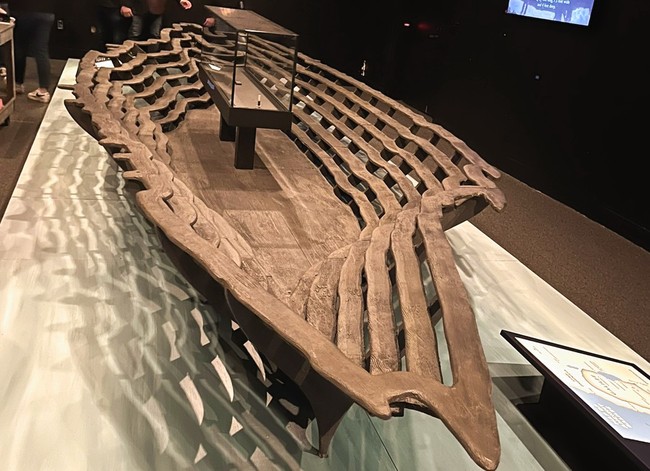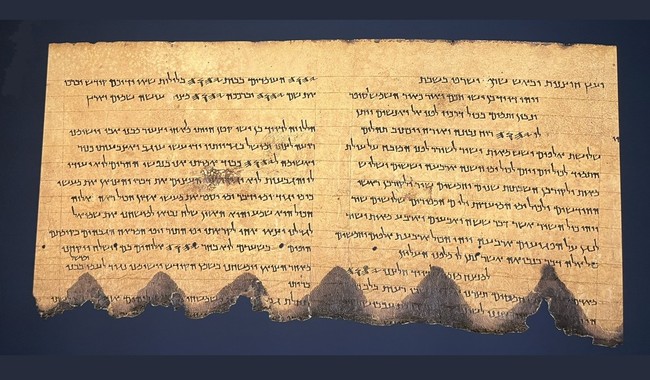This past week, I had the opportunity to view the exhibit of the Dead Sea Scrolls at Union Station in Kansas City, Missouri. It was extremely well done and provided an amazing look at the history and culture of those times. It runs for several more months here before moving on to Los Angeles, and I recommend it to anyone who will be in the area. Here are some comments from area clergy about the significance of the Scrolls. The words of Warren Carter, in particular, caught my attention when contrasted to some of the postings here.
=======================================
What faith leaders say about the Dead Sea Scrolls
Scholars and others reflect on significance of the exhibit.
By HELEN T. GRAY
KansasCityStar.com
Sat, Feb 17, 2007
Scholars have called the Dead Sea Scrolls the greatest archaeological discovery of the 20th century. And from what the scrolls reveal, they have lived up to their billing.
Now as thousands of people from throughout the Midwest flock to Union Station to view the Dead Sea Scrolls exhibit, local religious leaders express their views on the importance of the scrolls.
“We see how a community, somewhat on the periphery of the normative Jewish community, helped to create a bridge to what would emerge as the early Christian world in the first several centuries of the Common Era. … And the literature they preserved, the biblical texts, and the more sectarian texts that the Dead Sea community wrote and those items that were preserved and discovered in the caves give us tremendous insight into both the development of biblical texts, and also by looking at the manual of discipline, for example, something about the social character and religious character of that community.” --Rabbi Alan Cohen, Congregation Beth Shalom, Overland Park
“Research on the Dead Sea Scrolls has changed the way we think about the origins of the early Christian movement. The scrolls and other Jewish texts have shown that the old stereotype of first-century Judaism as legalistic and bound up in dead ritual was historically inaccurate. The new picture emphasizes diversity, vibrancy, debate, mercy, faithfulness and the importance of covenant. Jesus, Paul and other New Testament writers are shaped by this world.” --Warren Carter, professor of New Testament, St. Paul School of Theology, Kansas City
“With the discovery of the Dead Sea Scrolls in 1947, Scripture scholars now had the earliest texts by which to examine the Hebrew Scriptures, taking us back almost a thousand years from the often used Masoretic text. … The non-biblical texts found at Qumran gave us new insights into the community who produced these texts, with a vision of their faith and belief at a critical time in the history of both Judaism and Christianity. To this very day, scholars continue to examine the Dead Sea Scrolls to help us understand more fully the origin and development of the texts of the Bible.” --Abbot Gregory Polan, Conception Abbey, Conception, Mo
“The Dead Sea Scrolls provide a wonderful link between the Hebrew Scriptures and Jewish life at the time of Jesus. They show the honor given to the written Word of God and continuing attempts to interpret it.” --Molly Marshall, president, Central Baptist Theological Seminary, Shawnee, Ks.
“For Hebrew Bible/Old Testament studies, the Dead Sea Scrolls demonstrate the centuries-long integrity of the process of hand-copying the biblical manuscripts before the invention of the printing press. For Second Temple/New Testament studies they are another example of the yeastiness of Jewish religious life in its homeland in the first century of the Common Era. They gained no large following, and the first revolt against Rome wiped them out, but the Qumran sectarians continue to capture popular attention today because of their vivid, messianic and apocalyptic vision of the end of days.” -- Joseph Coleson, professor of Old Testament, Nazarene Theological Seminary, Kansas City.
“I believe we are linked through faith to those first Christians, and the more that we know about them and their world, the more fully documents that were written at that time, such as the books of our Bible, can be a living, breathing contribution to our walk with God today. The Dead Sea Scrolls are so valuable because they provide a rich source of information about the world into which Jesus was born, about the people who wrote the Bible, and the people about whom the Bible was written. … Anything that can shed light on the people of those times, such as their habits, beliefs and culture, can only contribute to a fuller understanding of the book that we understand to be the Word of God.” --The Rev. Amy Lignitz Harken, minister, First Christian Church of Independence


